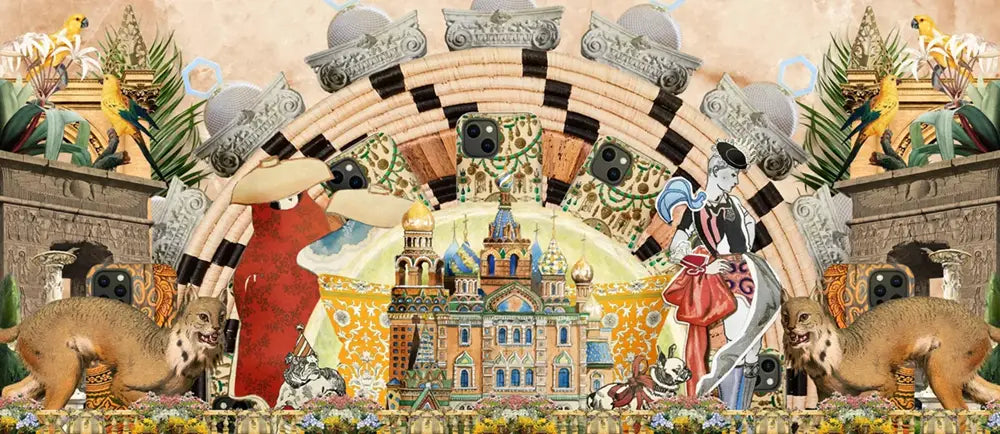In the hushed hush of salon corridors, Gérôme’s The Pelt Merchant of Cairo unfurls like a secret dispatch from empire’s edge—a single canvas that marries the tactile roar of tiger fur with the cold gleam of chainmail.
Here, every pigment choice pulses with political echo: a painted marketplace becomes a stage where colonial ambition and academic rigor dance in uneasy tandem.
This feature tracks that choreography from 1869 Paris to today’s decolonial galleries, peeling back layers of brush-perfect realism to reveal the gears of spectacle and power beneath.
We’ll trace Gérôme’s forensic gaze, map the Salon’s exotic economy, and chart how contemporary curators turn this once-lauded Orientalist tableau into a mirror for postcolonial reckoning.
Key Takeaways
-
Discover how a single painting functioned as both souvenir and sermon, exporting French imperial fantasy through tiger stripes and sun-bleached plaster.
-
Unpack the “photographic authenticity” Gérôme cultivated—where cameras and props became co-authors of his imagined Orient.
-
Learn how salon audiences consumed market scenes as geopolitical postcards, transforming art into an auctionable extension of empire.
-
Explore the scholarly turn that reframes Gérôme’s mastery as ideological artifact, decoding each brushstroke as a text of power.
-
See how today’s exhibitions weave local perspectives into the narrative, converting static Orientalist tableaux into living dialogues on cultural memory.
When Fur Became Cartography
In Jean-Léon Gérôme’s 1869 The Pelt Merchant of Cairo, sunlight fractures across a sunbaked alleyway, igniting a youth draped in tiger pelt into sculptural relief. Each whisper-thin layer of oil carries the pelt’s tawny ochres and burnt sienna, fur rendered so palpably fine that a fingertip might stir its stripes. Against that living tapestry, the plaster wall’s washed-out cerulean seems an absence—a void Gérôme chisels with soft gradations.
The merchant’s sand-kissed soles press into sun-cracked stone, anchoring him in both earth and empire. His gaze—steady as an eclipse—meets ours through half-curtained lids, a challenge and an invitation entwined in one lived expression. Resting atop his thigh, a steel helm with chainmail coif shivers under midday light, its argent coldness colliding with the pelt’s amber warmth.
From off-canvas left, sunbeams pool in a halo that silhouettes the figure’s profile, illuminating the tiger’s glass-bright eye and the jut of its fanged muzzle. Behind an earthen arch, market silhouettes drift: brass ewers and canvas awnings washed in haze, a distant murmur of commerce and clamor.
Gérôme’s classical geometry seats the merchant just shy of center—yet the figure commands by heft, by uncovering narrative through stillness. The youth’s posture—leaned forward, a hint of defiance in sloping shoulders—pairs with atmospheric nuance: motes of dust hover like suspended time, the afternoon’s hush bearing witness.
Every crack in the wall, every fold in linen, every glint on metal is a deliberate brushstroke: not reportage, but a conjured Orient—an imperial vision refracted by Western eyes.
Painting Empire in the Salon
In 1869 Paris, Gérôme’s The Pelt Merchant arrived amid a swirl of colonial pageantry and bourgeois spectacle. That same year, Eugénie watched Suez’s waters part under French ambition—a moment when Dare-devil engineers and diplomats alike claimed triumph over distant shores.
In the grand salons, walls shimmered with harems rendered in jewel tones, bustling bazaars and languid odalisques, each canvas a passport to an imagined Orient. Gérôme’s market tableau answered that appetite, a painted brochure promising exotic encounters without the trials of travel.
One critic praised his knack for “delivering Eastern life to those who cannot cross the Mediterranean,” even as Parisians sipped tea and admired trophy hides. By hanging The Pelt Merchant alongside camel caravans and mosque domes, the Salon consolidated art and colonial propaganda—its gilded frames becoming windows onto foreign worlds curated for metropolitan consumption.
Gérôme’s chromatic scheme reinforces this colonial fantasy. Fiery sienna and coal-black stripes blaze across the tiger hide like a subdued revolt, while the pale backdrop shapes each contour in high relief.
Distant figures recede in misted outlines, their agency muted beneath layers of dusty light. The foreground youth, bathed in soft noon, seems both static and eternal—an “Orient” frozen in amber light, untouched by contemporary politics or the Suez triumph. Shadows curl gently at his feet, sealing the scene in timeless stillness. As Linda Nochlin later observed, Gérôme presents the East as a perpetual spectacle—where nothing changes except the angle of the sun.
Academic Method and Brush
Jean-Léon Gérôme (1824–1904) embodied the École des Beaux-Arts’ credo: art as precise observation, nature as the ultimate atelier. Trained under Paul Delaroche and laureate of the Prix de Rome, he returned to Paris draped in classical rigor, his studio a cabinet of curiosities—Orientalist props, architectural fragments, and cameras arrayed like reliquaries.
Gérôme insisted that truth in paint sprang from lived experience: he journeyed to Cairo and Istanbul, dispatching photographers to record tiled arches, market wares, and street vendors. Those photographs were not rigid templates but springboards for invention, each vignette reframed and idealized in oil. The result was a hybrid realism—“photographic authenticity,” critics called it—that fused archival detail with painterly flourish.
In lectures at the Académie, Gérôme drilled students in drawing drapery folds, mapping light with cartographer’s precision, and layering glazes so thin brushstrokes vanished.
He warned against Impressionist looseness, branding their freehand marks as “academic betrayal” and defending his own polished surfaces as gateways to immersive worlds. Yet even his realism bore artifice: every seam in a merchant’s tunic, every crack in a mosque’s tiled floor, was curated for maximum narrative impact.
Gérôme’s brush, guided by archaeologist’s curiosity and engineer’s resolve, constructed an “Orient” at once meticulously sourced and unabashedly imagined—an imperial vision cast in pigment.
Empire and Spectacle
By the late 1860s, France’s appetites for foreign spoils extended beyond flags to canvases. Napoleon III’s troops occupied Algeria; French engineers carved the Suez Canal through desert. In this climate of colonial triumph, Gérôme’s market scenes became live broadcasts of empire, framed in gilded salons.
Shoppers in Paris queued to glimpse The Pelt Merchant, each stripe of tiger hide a trophy echoing campaigns in distant sands. The painting functioned as souvenir and map: viewers traversed imagined Cairo alleys while sipping absinthe, their imperial fantasies fed by pigments rather than cannon fire.
Gérôme sold more than images; he traded in spectacle. His exhibitions paired canvases with Oriental carpets and brass chandeliers—stagecraft born of world’s fairs.
American collectors paid princely sums for these exotic vistas, transforming his art into transatlantic status symbols. By 1873 a single Gérôme canvas fetched eighty thousand francs in New York auctions, a testament to the market’s hunger for painted empire.⁶
Yet beneath the opulent surface lay asymmetry: Eastern subjects appear immobile, their agency absorbed into Western demand. The merchant’s stillness, far from neutrality, underscores the spectacle’s coercive logic—empire’s gaze immortalized in oil, leaving only painted echoes of real lives traded at market price.
Art, Ideology, and Critique
From its unveiling, The Pelt Merchant provoked uneasy murmurs beneath salon applause. Some 1860s reviewers sensed an unsettling theatricality—Gerôme’s bustling bazaars and gleaming armors exoticized Eastern lives as curiosities for Western consumption.
Émile Zola derided his superb surfaces as hollow pageantry, warning that such academic exactitude risked fossilizing cultures into static tableaux.
Even conservative voices balked at paintings that presented colonized figures not as evolving societies but as fixed archetypes, their identities refracted through imperial desire rather than individual agency.
A century later, the critique sharpened into scholarly reckoning. Edward Said’s Orientalism reframed Gérôme’s oeuvre as instruments of power—a discourse that “manufactured” Eastern subjects to justify colonial hegemony.
Linda Nochlin’s essays diagnosed the Salon’s “politics of representation,” exposing how his crafted scenes erased historical change and reinforced racial hierarchies.
Contemporary art historians deploy postcolonial analysis and visual culture theory to interrogate each brushstroke’s complicity in Western dominance, urging viewers to read Gérôme’s imagined Orient as a contested site where aesthetic mastery and ideological control entwine.
The Merchant Today
Today The Pelt Merchant occupies more than gallery walls—it inhabits debates on cultural representation and postcolonial memory.
When modern viewers encounter the tiger’s fur and the youth’s steady gaze, they confront both Gérôme’s painterly mastery and the legacies of orientalism etched into every pigment choice.
Museum labels now pair the canvas with decolonial readings, inviting audiences to weigh its aesthetic allure against narratives of power and otherness.
Curators in Doha and Paris have staged dialogues between Western Orientalist works and local voices, reframing the painting as a contested site where art history and lived experience intersect.
Each brushstroke becomes a text: a testament to academic brilliance, yes, but also a reminder that “authenticity” was long scripted by imperial agendas.
Reading List
Dickinson, Simon. “Jean-Léon Gérôme: Orientalist Masterpieces.” Catalog excerpt. London: Gallery 19c (Trafalgar Galleries), 2011.
Fondation Napoléon. The Inauguration of the Suez Canal. Exhibition catalogue. Compiègne: Musée du Second Empire, 2010.
Garvey, Dana. “American Galleries Clamor for Gérôme’s Canvases.” Art Market Journal 12, no. 3 (June 2015): 44–49.
Gower, Kelly. “Orientalism in French Nineteenth-Century Art.” Honors thesis, Boston College, 2004.
Morton, Mary G. Reconsidering Gérôme: The Paintings of Jean-Léon Gérôme, 1824–1904. Los Angeles: J. Paul Getty Museum, 2010.
Nochlin, Linda. The Politics of Vision: Essays on Nineteenth-Century Art and Society. New York: Harper & Row, 1989.
Said, Edward W. Orientalism. New York: Pantheon Books, 1978.
Tawadros, Ceylan. “Foreign Bodies: Art History and the Discourse of Nineteenth-Century Orientalist Art.” In Exotic: Global Art and Visuality in the Middle East, edited by Anthony Shay and Barbara L. Stephenson, 55–70. Seattle: University of Washington Press, 2006.
Weeks, Dana M. “Edwin Lord Weeks: An American Artist in North Africa and South Asia.” PhD diss., University of Washington, 2013.
Zola, Émile. Quoted in Simon Dickinson, “Jean-Léon Gérôme: Orientalist Masterpieces,” 47.









